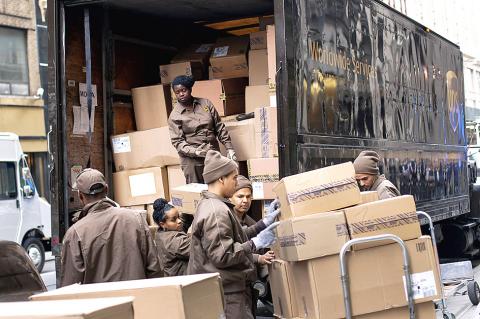Amazon.com Inc and other retailers are on pace to sell more products online than ever this holiday season, aided by early promotions and investments in delivery systems that helped avoid the widespread shipping delays of last year.
Web sales rose 14 percent from Nov. 27 to Dec. 21, consulting firm ChannelAdvisor Corp said in a statement earlier this week.
That is roughly in line with ComScore Inc’s forecast last month that online purchases would gain 16 percent to US$61 billion during the three months through December. The total may include US$7.9 billion in mobile sales, ComScore said.

Photo: Bloomberg
Amazon.com hired more workers and opened new distribution centers to get goods to customers faster.
United Parcel Service Inc and FedEx Corp also stepped up hiring, updated technology and spent on infrastructure to absorb the growth.
Consumers, aided by lower unemployment and cheaper gas, responded to pre-Thanksgiving promotions instead of splurging at the last minute, something that contributed to last year’s delivery delays.
“Shoppers were aware of last year’s problems, and the e-commerce companies and shipping companies were prepared,” said Jarrett Streebin, chief executive officer of EasyPost, a San Francisco company that helps retailers coordinate labels and tracking with delivery companies. “So far, it looks like everything went really well.”
On Christmas Day, consumers went online to buy music, applications and other content for new smartphones and tablets they received as gifts.
Online spending increased 8.3 percent on Thursday from a year earlier, International Business Machines Corp said on Friday. That compares with last year’s Dec. 25 growth rate of 17 percent.
The slowing growth on Christmas Day follows a broader trend of a longer shopping season with spending less concentrated on any particular day, IBM strategy program director Jay Henderson said.
“Consumers are spreading their spending out,” he said. “Overall, shopping is going to be strong for the whole period.”
Sales from third-party sellers on Amazon.com rose 20 percent from Nov. 27 to Dec. 21, ChannelAdvisor said. The Seattle-based retailer, the world’s largest online merchant, is projected to have fourth-quarter revenue of US$29.7 billion, up 16 percent from a year earlier, according to the average of analysts’ estimates compiled by Bloomberg.
More than 10 million new customers this holiday season tried Amazon Prime, the company’s US$99 annual subscription that offers delivery discounts and video streaming, Amazon announced on Friday. Those enrolled in Amazon Prime spend more on average than other customers.
Retailers did a better job getting orders to customers on time this year, said Kevon Hills, director for research at StellaService, which monitors customer service at e-commerce companies.
StellaService ordered 160 items from 40 retailers to be delivered to different regions of the country. About 7 percent of the packages ordered did not arrive on time, down from 12 percent last year.
There were fewer warehouse bottlenecks, and retailers communicated better with delivery companies this year, Hills said.
Amazon prepared for the holiday crush this year by hiring 80,000 seasonal workers, up from 70,000 last year. It also operated 15 sorting centers — up from eight last year — where packages are organized by ZIP code and trucked to post offices for the final mile of delivery. The new sorting centers helped Amazon reach more customers with Sunday deliveries, spreading orders over a greater number of days.
EBay Inc’s sales growth from the day after Thanksgiving to Monday lagged behind the industry at 10 percent, according to ChannelAdvisor.
Analysts predict the San Jose, California-based company will report sales for the current quarter of US$4.94 billion, up 9.1 percent from a year earlier, according to data compiled by Bloomberg.
“Expectations were very low for eBay,” ChannelAdvisor chief executive Scot Wingo said. “Long-term, eBay has to do something to right the ship.”
Smaller companies helped fuel the jump in e-commerce this season by investing in technology and embracing the Web to expand their reach. Growth in e-commerce will continue to outpace overall expansion in retail in coming years as consumers shift spending from brick-and-mortar stores to Web sites and mobile apps, according to eMarketer Inc.
Online sales in the US will top US$305 billion this year, representing 6.5 percent of all retail sales, the market researcher projects.
The US e-commerce market will grow to US$494 billion in 2018, representing 8.9 percent of total retail sales, it said.

To many, Tatu City on the outskirts of Nairobi looks like a success. The first city entirely built by a private company to be operational in east Africa, with about 25,000 people living and working there, it accounts for about two-thirds of all foreign investment in Kenya. Its low-tax status has attracted more than 100 businesses including Heineken, coffee brand Dormans, and the biggest call-center and cold-chain transport firms in the region. However, to some local politicians, Tatu City has looked more like a target for extortion. A parade of governors have demanded land worth millions of dollars in exchange

An Indonesian animated movie is smashing regional box office records and could be set for wider success as it prepares to open beyond the Southeast Asian archipelago’s silver screens. Jumbo — a film based on the adventures of main character, Don, a large orphaned Indonesian boy facing bullying at school — last month became the highest-grossing Southeast Asian animated film, raking in more than US$8 million. Released at the end of March to coincide with the Eid holidays after the Islamic fasting month of Ramadan, the movie has hit 8 million ticket sales, the third-highest in Indonesian cinema history, Film

Taiwan Semiconductor Manufacturing Co’s (TSMC, 台積電) revenue jumped 48 percent last month, underscoring how electronics firms scrambled to acquire essential components before global tariffs took effect. The main chipmaker for Apple Inc and Nvidia Corp reported monthly sales of NT$349.6 billion (US$11.6 billion). That compares with the average analysts’ estimate for a 38 percent rise in second-quarter revenue. US President Donald Trump’s trade war is prompting economists to retool GDP forecasts worldwide, casting doubt over the outlook for everything from iPhone demand to computing and datacenter construction. However, TSMC — a barometer for global tech spending given its central role in the

Alchip Technologies Ltd (世芯), an application-specific integrated circuit (ASIC) designer specializing in server chips, expects revenue to decline this year due to sagging demand for 5-nanometer artificial intelligence (AI) chips from a North America-based major customer, a company executive said yesterday. That would be the first contraction in revenue for Alchip as it has been enjoying strong revenue growth over the past few years, benefiting from cloud-service providers’ moves to reduce dependence on Nvidia Corp’s expensive AI chips by building their own AI accelerator by outsourcing chip design. The 5-nanometer chip was supposed to be a new growth engine as the lifecycle